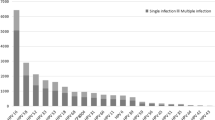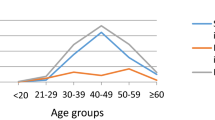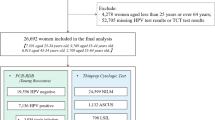Abstract
Objective
The aim of this survey was to assess the prevalence and type distribution of oncogenic human papillomavirus (HPV) infections among women in Wufeng County of Hubei province, where the cervical cancer mortality rate is the highest in China Cervical.
Methods
DNA samples were collected from 1,100 women, then screened and quantified by a multi-fluorescent, quantitative real-time PCR assay. The cervical DNA samples were then re-typed by real-time PCR using seven-pair primers of high-risk (HR) HPVs designed to detect types 16, 31, 18/45, 33, 52, 58, and 67.
Results
The overall prevalence of HR HPVs was 11.14 % (95 % CI, 9.74–13.72 %) in Wufeng County, which was not statistically different between Tu (12.17 %; 95 % CI, 10.03–12.34 %) and Han nationality (8.95 %; 95 % CI, 3.55–14.35 %). Among different types of HPV, HPV 16 was the most frequently detected genotype, followed by HPV 52, 58, 18/45, and 31. The most prevalent types of HR HPV in Tu nationality were HPV 16, 52, and 58, and the most prevalent types of HR HPV in Han nationality were HPV 16, 33, and 18/45. The overall prevalence of HPV was highest in the 20–24 year age group (21.43 %; 95 % CI, 17.56–25.30 %) and the prevalence of HR HPV was associated with education.
Conclusions
HPV 16, 52, and 58 are common genotypes in Wufeng County, and support the hypothesis that second-generation HPV prophylactic vaccines, including HPV 52 and 58, may offer higher protection for women in China and other areas of Asia. The findings of this study contribute to preventive and screening measures in clinical practice.
Similar content being viewed by others
References
Parkin DM, Bray F, Ferlay J, Pisani P (2001) Estimating the world cancer burden: Globocan 2000. Int J Cancer 94:153–156
Parkin DM, Bray F, Ferlay J, Pisani P (2005) Global cancer statistics, 2002. CA Cancer J Clin 55:74–108
zur Hausen H (2009) Papillomaviruses in the causation of human cancers—a brief historical account, 2009. Virology 384:260–265
zur Hausen H (1987) Papilloma virus in human cancer. Cancer 59:1692–1696
Smith JS, Lindsay L, Hoots B, Keys J, Franceschi S, Winer R, Clifford GM (2007) Human papillomavirus type distribution in invasive cervical cancer and high-grade cervical lesions: a meta-analysis update. Int J Cancer 121(3):621–632
Trottier H, Franco EL (2006) The epidemiology of genital human papillomavirus infection. Vaccine 30(24 Suppl 1):S1–S15
Sanjose S, Diaz M, Castellsague X et al (2007) Worldwide prevalence and genotype distribution of cervical human papillomavirus DNA in women with normal cytology: a meta-analysis. Lancet Infect Dis 7:453–459
Bao YP, Li N, Smith JS et al (2008) Human papillomavirus type distribution in women from Asia: a meta-analysis. Int J Gynecol Cancer 18(1):71–79
Lo KW, Wong YF, Chan MK et al (2002) Prevalence of human papillomavirus in cervical cancer: a multicenter study in China. Int J Cancer 100(3):327–331
Muñoz N, Bosch FX, de Sanjosé S et al (2003) Epidemiologic classification of human papillomavirus types associated with cervical cancer. N Engl J Med 348(6):518–527
Mandelblatt JS, Lawrence WF, Gaffikin L et al (2002) Costs and benefits of different strategies to screen for cervical cancer in less-developed countries. J Natl Cancer Inst 94:1469–1483
Kim K, Zang R, Choi SC, Ryu SY, Kim JW (2009) Current status of gynecological cancer in China. J Gynecol Oncol 20:72–76
Youyou W, Qunying X, Qian S et al (2011) HPV infection and re lated factors among women in high cervical cancer incidence area. Chin J Public Health 27:259–261
Smith JS, Melendy A, Rana RK, Pimenta JM (2008) Age-specific prevalence of infection with human papillomavirus in females: a global review. J Adolesc Health 43:s5–25, Se1–41
Thomas JO, Herrero R, Omigbodun AA et al (2004) Prevalence of papillomavirus infection in women in Ibadan, Nigeria: a population-based study. Br J Cancer 90:638–645
Kjaer SK, Chackerian B, van den Brule AJ et al (2001) High-risk human papillomavirus is sexually transmitted: evidence from a follow-up study of virgins starting sexual activity (intercourse). Cancer Epidemiol Biomarkers Prev 10:101–106
Ozçelik B, Serin IS, Gökahmetoğlu S et al (2003) Human papillomavirus frequency of women at low risk of developing cervical cancer: a preliminary study from a Turkish university hospital. Eur J Gynaecol Oncol 24(2):157–159
Bao YP, Li N, Smith JS, Qiao YL (2008) Human papillomavirus type distribution in women from Asia: a meta-analysis. Int J Gynecol Cancer 18:71–79
Clifford GM, Smith JS, Plummer M, Munoz N, Franceschi S (2003) Human papillomavirus types in invasive cervical cancer worldwide: a meta-analysis. Br J Cancer 88:63–73
Bhatla N, Lal N, Bao YP, Ng T, Qiao YL (2008) A meta-analysis of human papillomavirus type-distribution in women from South Asia: implications for vaccination. Vaccine 26:2811–2817
Acknowledgments
The authors thank Dr Xue-Feng Liu, Georgetown University Medical Center (Washington, DC) for technical contribution in real-time PCR analysis. This study was funded by grant from the National Natural Science Foundation of China (No. 30772308 and No. 81072123).
Conflict of interest
None of the authors has a financial relationship with a commercial entity that has an interest in the subject of this manuscript.
Author information
Authors and Affiliations
Corresponding author
Additional information
L. Zhang, Y. Wang contributed equally to this work.
Rights and permissions
About this article
Cite this article
Zhang, L., Wang, Y., Peng, M. et al. Prevalence and type distribution of high-risk human papillomavirus infections among women in Wufeng County, China. Arch Gynecol Obstet 286, 695–699 (2012). https://doi.org/10.1007/s00404-012-2344-0
Received:
Accepted:
Published:
Issue Date:
DOI: https://doi.org/10.1007/s00404-012-2344-0




